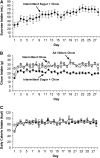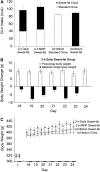Sugar and fat bingeing have notable differences in addictive-like behavior
- PMID: 19176748
- PMCID: PMC2714381
- DOI: 10.3945/jn.108.097584
Sugar and fat bingeing have notable differences in addictive-like behavior
Abstract
Ingestion of different nutrients, such as fats and sugars, normally produces different effects on physiology, the brain, and behavior. However, they do share certain neural pathways for reinforcement of behavior, including the mesolimbic dopamine (DA) system. When these nutrients are consumed in the form of binges, this can release excessive DA, which causes compensatory changes that are comparable to the effects of drugs of abuse. In this article, we review data obtained with animal models of fat and sugar bingeing. The concept of "food addiction" is described and reviewed from both clinical and laboratory animal perspectives. Behavioral manifestations of addictive-like behavior and concomitant alterations in DA and opioid systems are compared for sugar and fat bingeing. Finally, in relation to eating disorders and obesity, we discuss how fat may be the macronutrient that results in excess body weight, and sweet taste in the absence of fat may be largely responsible for producing addictive-like behaviors that include a withdrawal syndrome.
Figures


References
-
- Ogden CL, Yanovski SZ, Carroll MD, Flegal KM. The epidemiology of obesity. Gastroenterology. 2007;132:2087–102. - PubMed
-
- Stunkard AJ. Eating patterns and obesity. Psychiatr Q. 1959;33:284–95. - PubMed
-
- Ramacciotti CE, Coli E, Paoli R, Gabriellini G, Schulte F, Castrogiovanni S, Dell'Osso L, Garfinkel PE. The relationship between binge eating disorder and non-purging bulimia nervosa. Eat Weight Disord. 2005;10:8–12. - PubMed
Publication types
MeSH terms
Substances
Grants and funding
LinkOut - more resources
Full Text Sources
Other Literature Sources
Medical

